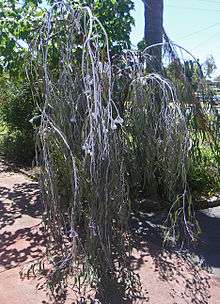Eucalyptus caesia
| Gungurru | |
|---|---|
 | |
| Scientific classification | |
| Kingdom: | Plantae |
| Clade: | Angiosperms |
| Clade: | Eudicots |
| Clade: | Rosids |
| Order: | Myrtales |
| Family: | Myrtaceae |
| Genus: | Eucalyptus |
| Species: | E. caesia |
| Binomial name | |
| Eucalyptus caesia Benth. | |
| Subspecies | |
|
E. caesia subsp. caesia | |
| | |
| E. caesia, field distribution | |


Eucalyptus caesia, commonly known as caesia, gungurru or silver princess, is a mallee of the Eucalyptus genus that is endemic to Western Australia. The name "silver" refers to the white powder that covers the branches, flower buds and fruit. "Gungurru" comes from the name used by the indigenous Noongar people.
Description
The tree has a weeping habit and typically grows to a height of 2 to 14 metres (6.6 to 45.9 ft)[1] with an average of about 6 metres (20 ft). Young stems, leaves, buds and fruit are blue-green in colour and are covered in a showy white, waxy bloom. The trunk has deep brown minni-ritchi bark that peels in small curly flakes but does not detach[2] to reveal a pale undersurface.[3] The foliage is a deep green to dull grey-green colour with a whitish bloom,[3] they are concolorous, thick and have a narrow lanceolate shape. Adult leaves are disjunct, basally tapered with obscure lateral veins.[4]
It blooms through the winter from May to September producing flowers that range in colour from pink to red[1] and are up to 4 to 5 centimetres (1.6 to 2.0 in) in diameter.[2] It is a simple axillary conflorescence wuth three-flowered umbellasters on terete peduncles.[4] Flowers are followed by large, urn-shaped gumnuts that are approximately 30 mm (1.2 in) in diameter. The species will also develop a lignotuber.[3]
Propagation is from seed which germinates readily.[3]
Two subspecies have been identified: caesia (about 6–9 metres tall) and magna (up to 15 metres tall). The bark is red-brown, of the curly minni ritchi type. Branches tend to flail or weep on the ground. Trees have large red-pink or white flowers, 40-50mm in diameter. They are widely grown as ornamental native plants, but have become rare in the wild.
Distribution
It is found the central Wheatbelt region of Western Australia, where it is found on a small number of granite outcrops growing in loamy soils. It has a patchy distrubtion and is found as far west as Pingelly, east as Yilgarn, Western Australia, south as Lake Grace and north as Trayning.[1] The species is known to be drought tolerant.[5]
The species occurs in low woodlands and often in pure stands where they are confined to growing in crevices at the base of granite outcrops in loamy soils often with a coarse sand component. Associated species include Eucalyptus crucis, Eucalyptus loxophleba, Allocasuarina huegeliana and Acacia lasiocalyx.[6]
Taxonomic history
Eucalyptus caesia was named in 1867 by George Bentham from specimens collected by James Drummond in 1847. It was first formally described in the work Orders XLVIII. Myrtaceae- LXII. Compositae. Flora Australiensis.[7] Drummond made his collection too late in the season to gather buds and flowers, and this made later identification difficult. During the Elder Scientific Exploring Expedition of 1891–2, Richard Helms gathered specimens of a Eucalyptus that the Indigenous Australians of the area called "Gungurru". This was almost certainly Eucalyptus woodwardii, but in 1896 it was misidentified by Mueller and Tate as E. caesia. This led to the incorrect application of the common name "Gungurru" to E. caesia, and to confusion about the species' distribution.
Authenticated collections of E. caesia were later made by A. Morrison in 1885, and in 1923 Charles Gardner collected specimens from a form with considerably larger leaves, buds, flowers and fruits. This was later recognised as subspecies magna by Brooker and Hopper (1982), with the original form being designated subspecies caesia.
The name caesia is from the latin word, caesius, meaning light grey, referring to the greyish appearance of the buds, fruit and stems.[3]
See also
References
| Wikispecies has information related to: Eucalyptus caesia |
- 1 2 3 "Eucalyptus caesia". FloraBase. Western Australian Government Department of Parks and Wildlife.
- 1 2 "Silver Princess Eucalyptus caesia" (PDF). Native Plant Notes. Kings Park and Botanic Gardens. Retrieved 29 April 2017.
- 1 2 3 4 5 "Eucalyptus caesia". Australian Native Plants Society. Retrieved 29 April 2017.
- 1 2 "Eucalyptus caesia Benth., Fl. Austral. 3: 227 (1867).". Eucalink. Royal Botanic Garden, Sydney. Retrieved 29 April 2017.
- ↑ "Eucalyptus caesia "Silver Princess"". Rebel Gardener. 2011. Retrieved 29 April 2017.
- ↑ Douglas J. Boland; Maurice William McDonald (2006). Forest Trees of Australia. CSIRO publishing. ISBN 9780643069695.
- ↑ "Eucalyptus caesia Benth.". Atlas of Living Australia. Global Biodiversity Information Facility. Retrieved 29 April 2017.
External links
- Eucalyptus caesia Association of Societies for Growing Australian Plants (ASGAP)
- Illustration by Morag Newman
- Illustration by Helen Fitzgerald
